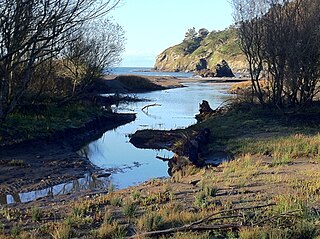Redwood Creek (Marin County)
| Redwood Creek | |
| stream | |
|
Redwood Creek flowing west to its mouth at Muir Beach (photo credit: Hugh Kuhn)
|
|
| Country | United States |
|---|---|
| State | California |
| Region | Marin County |
| Tributaries | |
| - left | Fern Creek, Green Gulch Creek |
| - right | Kent Creek |
| Source | Mount Tamalpais confluence of Bootjack, Rattlesnake and Spike Buck Creeks |
| - coordinates | 37°54′14″N 122°35′22″W / 37.90389°N 122.58944°W |
| Mouth | Pacific Ocean |
| - location | Muir Beach, California |
| - elevation | 0 ft (0 m) |
| - coordinates | 37°51′35″N 122°34′40″W / 37.85972°N 122.57778°WCoordinates: 37°51′35″N 122°34′40″W / 37.85972°N 122.57778°W |
| Length | 4.7 mi (8 km) |
| Basin | 7 sq mi (18 km2) |
Redwood Creek is a short but significant stream in Marin County, California. 4.7 miles (7.6 km) long, it drains a 7-square-mile (18 km2) watershed which includes the Muir Woods National Monument, and reaches the Pacific Ocean north of the Golden Gate at Muir Beach.
At the time of European discovery, the watershed was inhabited by the Coast Miwok, of which the local Huimen tribe was one of fifteen independent Miwok tribes in Marin and southern Sonoma counties. The indigenous archeological site named CA-MRN-33 on the edge of Big Lagoon is listed on the National Register of Historic Places as the Muir Beach Historical Site. The Banducci family grew hay and flowers on a 170-acre (0.69 km2) parcel 1/2 mile upstream from the lagoon, and constructed levees along the right banks in 1948-1949 to prevent overbank flooding. These historical actions created an artificially-straight, constrained stream with relatively little habitat heterogeneity, nicknamed the “Bowling Alley” reach. The NPS acquired this property in 1980, with an agreement allowing the Banduccis to continue farming until 1995. In 1945, George Wheelwright, a co-founder of Polaroid, purchased the Green Gulch Farm and Muir Beach where he created pasture by constructing drainage channels, levees, a dam and a large drainage channel along Redwood Creek. In 1967, Wheelwright donated the Muir Beach area to the California State Parks who built a large parking lot in the current location by the beach. In 1972, Wheelwright sold the Green Gulch Farm to Zentatsu Richard Baker who transformed the ranch into the Green Gulch Farm Zen Center.
Redwood Creek provides a critical spawning and rearing habitat for coho or silver salmon (Oncorhynchus kisutch), coastal cutthroat (Oncorhynchus clarki clarki) and steelhead trout (Oncorhynchus mykiss), each of them threatened species. The creek is near the southernmost limit of coho habitat and the fish have never been stocked, so they have a distinctive DNA. The Redwood Creek salmon are Central Coast coho salmon which have been listed as federally threatened species since October 2006 and as federally endangered species in June 2005. Coho migrate from the ocean back to freshwater for a single chance at reproduction, generally after two years in the ocean. The spawning migrations begin after heavy latefall or winter rains breach the sandbar at Muir Beach allowing the fish to move upstream (usually in December and January). No salmon were seen in the 2007-2008 winter run, nor the 2008-2009 winter run. Evidence points to exhaustion of smolt oversummering in the creek due to a loss of large woody debris and deep pools where young salmon can rest. Starting in 2009, the National Park Service will begin restoring Muir Beach to create a functional, self-sustaining ecosystem and improve visitor access. The intervention was almost too late, since the coho only has a three-year life span. Fortunately, as of January, 2010 and for the first time in three years, an estimated 45 coho swam up Redwood Creek to spawn, creating 23 redds or clusters of eggs. In 2011, 11 live adult coho and 1 coho carcass was observed, along with three redds, a modest increase over the 2007-2008 spawning season. Statewide the coho population is 1% of its levels in the 1940s and the fish have vanished from 90% of the streams they formally visited. The Watershed Alliance of Marin reported that no salmon returned to spawn in 2014, prompting concerns that the fish may now be locally extinct. Three adult male coho captured from the creek as juveniles in 2014 were released with three Olema Creek females as part of California Department of Fish and Wildlife operation "coho jumpstart", and at least one of the latter was observed to spawn, raising hopes of a return of a viable spawning run in Redwood Creek.
...
Wikipedia

